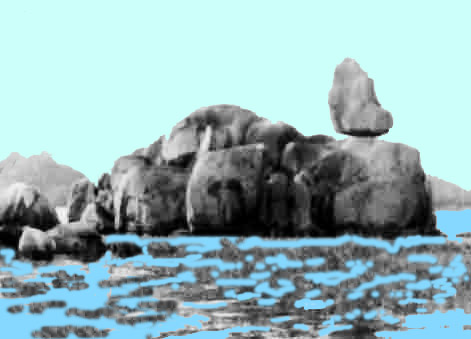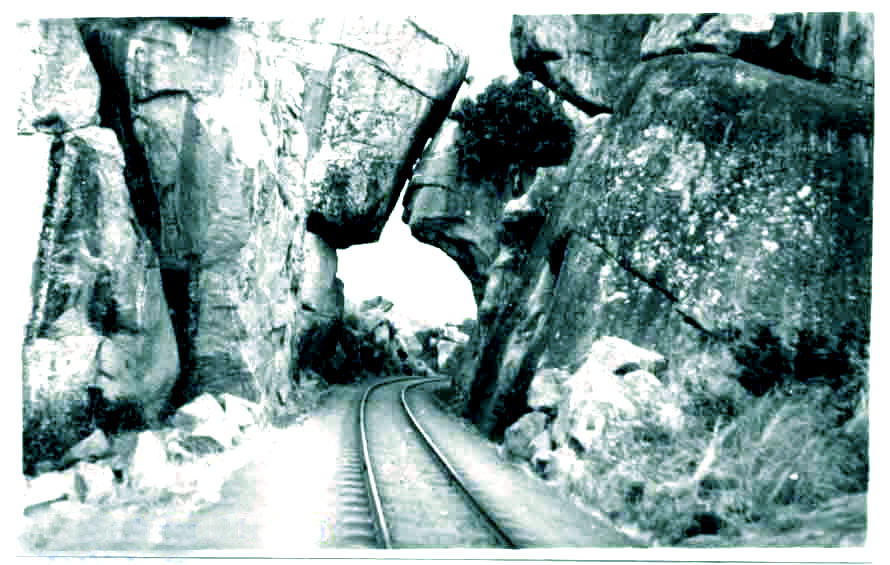6 The Mwanza Rocks
One afternoon I was watching a big group of nyani, monkeys, which came down from the hills to feed on the figs and of course for a drink. As I looked at the lake, I noticed that the water was very low and there were smaller rocks I could hop over to reach the base of the Chair. I stood by the water edge and checked these rocks very carefully because I did not want to fall in the lake. On the one hand, I did not then know how to swim and worse, there were all the crocodiles. The crocodiles often stayed close to the rocks to snap at the water birds. Besides, I had seen monkeys snapped up as they drank at water’s edge or off a half-submerged rock.
Yet feeling safe, I took off my shoes and socks and placed these under the fig tree. This was so mum and dad would not know that I had been in the lake. Very cautiously, I entered the water. Looking out for the crocodiles, I waded to the first rock. Standing on it, I felt very brave and secure. I thought no crocodile could grab me from here, which of course was not true. For the moment, I was only thinking of getting to the base rocks of the Chair. There were a couple of rocks a bit bigger than they appeared from the shore but I managed to clamber over these. Then climbing over other small outcrops, which led to the base of the huge granite raise I landed on a rather flat slab.
I was tremendously excited as I stood on this slab for I knew that no other children had come up here. The lower rock base was so huge and wide that I could not see the Chair. Other very huge pieces leaned and braced against one another. As I wanted to get to the Chair, I began to explore, looking for cracks or footholds to help me climb to the top. Halfway along the base, I could not observe the shore but I could see the port in the distance. I went further along but the rocks were sheer, smooth and quite high. The tops were white from the droppings of the water birds and several large skinks scrabbled about. I was, however afraid of going any farther around, as it would take me towards very deep water. So I sat there for a while watching the shunting at the port and the shoreline. Then I began the return ashore. A little distance before one slopping slab, I noticed a door sized opening between two rocks, which I must have missed earlier. I looked in and saw that it did not go very far in and was quite bright, so I entered it to explore.
I found fishing net draped over a pole on one side and a bundle of thin sticks near it. These sticks were used to make cone shaped fish traps, weighed down and lowered in the water. On the opposite wall was a stone fire near which was a very dented and blackened aluminum sufuria, cooking pot. Around the fire and in the ash and burnt pieces of wood were lots of fish bones and scales. Most had dried but some were also charred or half-burnt. As I stirred the ash with a half-burnt stick, I remembered something. A berry tree that was not far from the rock base, always had a dug out canoe tied to it.
Now I became very worried and even quite scared. During our evening walks along here, I had often seen this fisherman but had never met him and so he was not a rafiki, a friend, yet. What if he suddenly arrived and found me in his cave. Besides it was also getting late in the afternoon and I needed to be back home playing in the garden. I hurried out of the cave to get back to the shore. As I rounded one of the rocks there was a sudden loud shriek and great flapping noises. I was so scared that I stopped and cried out aloud. I was shaking and my heart thumped. Four cormorants drying on the rocks had heard me and flown off in alarm. After I calmed down, I made it back to the shore as quickly as I could.
My shoes and socks in my hands I took all the short cuts I knew. Across the town ground, past the only church in the town, through the post office grounds and over the soccer field I ran. Here I skirted the Monkey Hill, which ran behind one row of shops and into the main street past the vishy the Indian hotel. A track beside the vishy led to our street, and through my hole in the fence, I shot into our garden. I hauled myself up a flamboyant tree and waited for the call for bath.
Another well-known rock about thirty meters high was right on the water’s edge some distant from the Chair. This was known as Bismarck rock. The old timers explained that when the Germans ruled Tanganyika they placed Bismarck’s statue on the top of this rock. Bismarck was a German political figure who was responsible for acquiring parts of Africa for Germany.
The most famous of all the rock formations was the Arch a little out of Mwanza South. The Mwanza - Dar-Es-Salaam railway runs along a rock dotted plain here. At one spot on this plain, there are two very high and almost straight rocks. The top of one of these rocks leans very firmly against the top of the other, forming a natural arch. The gap between the rocks was wide enough for a train to go through. When the railway was built, the track was laid through this natural arch. On the days the train left for Tabora and Dar- Es-Salaam, people went to the Arch to see the train pass under.
Little Potty was another rock formation not far from the Arch. On a high, long, gently slopping tear shaped enormous base rock, sat a very big rounded rock with a small hump. There was a shallow dip below the hump and on the rim opposite this hump, there was a lip like that of a giant jug. Rainwater running over the lip had left streaks over the rock. The watermarks and the shape gave it the name Little Potty. It was possible to walk over the elongated base rock all the way to the Potty but the Potty itself was a very large room-sized rounded boulder, like a gigantic marble and impossible to climb. We sat under it and waved at the train as it approached the Arch, and there was always a long whistle for us.
Mwanza is both a very important railhead and a lake port on the southern shore of Lake Victoria. From Mwanza the railway goes due south to Tabora, which is nearly in the centre of Tanganyika, now Tanzania. From here, it branches off east to Dar-Es-Salaam the old capital, on the Indian Ocean. The other branch swings west and south to Kigoma a town on Lake Tanganyika. It is one of the several lakes in the longest valley on our planet the Great Rift Valley, which the astronaut can easily spot withiout using binoculars.
Not very far from Kigoma is another historical town, Ujiji. It was close to Ujiji that, in 1871, Henry M. Stanley found the explorer Dr. David Livingstone and greeted him with the now famous words, “Doctor Livingstone, I presume.”

